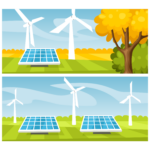Albania tops region for sustainable energy mix
Reading Time: 2 minutesThe share of renewable sources in gross final energy consumption at the EU level reached 23% in 2022, up 1.1 percentage points (pp) year-on-year, the bloc’s statistics office Eurostat reports.
The EU’s revised Renewable Energy Directive has upped the bloc’s 2030 renewable energy target from 32% to 42.5%, with a further aim to later increase it to 45%, meaning countries will need to collectively increase the EU’s proportion of renewable energy sources in gross final energy consumption by almost 20pp. In CEE, only Latvia exceeded 42.5% in 2022.
CEE performs well in sustainable energy compared to Western Europe
Albania was top in Central and Eastern Europe (CEE), with 44.1% green energy consumption, just ahead of Latvia on 43.3%. Next in CEE were Montenegro (39.9%), Estonia (38.5%) and Austria (33.8%).
In the subsequent grouping of countries were Lithuania (29.6%), Croatia (29.4%), Serbia (27.1%), Romania (24.1%), Slovenia (22.9%), Greece (22.7%) and Moldova (21.5%).
Bulgaria was next with 19.1%, followed by Kosovo (18.8%), North Macedonia (18.7%) and Czechia (18.2%). The stragglers were Slovakia (17.5%), Poland (16.9%) and, in last place, Hungary (15.2%).

Sweden top in EU, ahead of Finland, Latvia
Sweden had the EU’s highest share of energy from renewable sources, with 66% of its gross final energy consumption in 2022 derived from renewable sources, followed by Finland (47.9%) and Latvia (43.3%), which depended mostly on hydro power.
The lowest proportions of renewables were recorded in Ireland (13.1%), Malta (13.4%), Belgium (13.8%) and Luxembourg (14.4%). Overall, 17 of the EU-27 had green energy mixes below the EU average of 23% in 2022.

